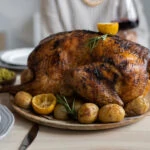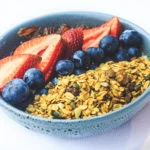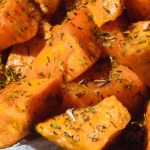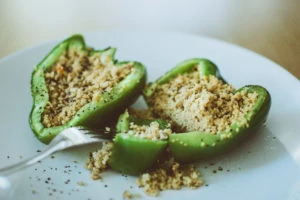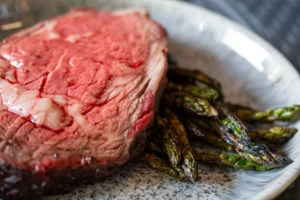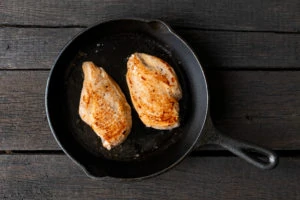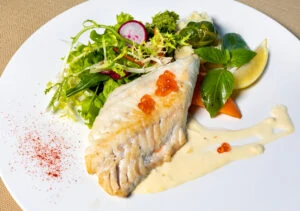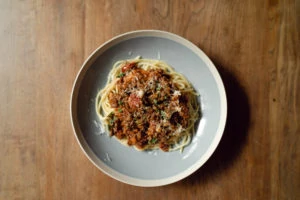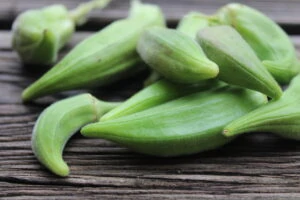Make easy hummus without tahini using dried chickpeas for the most flavorful and creamy homemade dip that’s easier than you think to whip up at home.
How do you make hummus without tahini from dried chickpeas? First soak the chickpeas overnight, rinse them, fill a large pot with water, add the chickpeas, salt to taste, boil for 5 minutes, simmer for an hour or until soft. Then turn them into creamy and delicious hummus in a food processor with water, olive oil, lemon juice, ground cumin and garlic.
There are plenty of reasons to love chickpeas. They’re deliciously nutty tasting but mild enough to pair well with a variety of seasonings. Plus, these pulses are shelf-stable when they’re dried or canned, making them easy to store and transport. In addition, chickpeas provide plant-based protein, making them a great option for vegan and vegetarian eaters. And finally, you can eat chickpeas in a wide variety of dishes. From crispy baked chickpeas that are addicting as a crunchy snack to creamy whipped hummus, the humble chickpea is a true powerhouse in the kitchen.
Today we’re covering exactly how to transform dried chickpeas into the creamiest hummus without tahini. The result is amazingly simple but delicious with warm pita or your favorite crunchy veggies for dipping.
What are Chickpeas?
Chickpeas, also called garbanzo beans, are a member of the legume family. In fact, these humble beans have been harvested for at least 7500 years, making them one of the earliest known cultivated legume crops. Chickpeas are common in cuisines in Asia and the middle east, especially India and Israel. You’ll also find chickpeas in many Mediterranean dishes, including those from Italy and North Africa. They’re a healthy protein source that’s easy to prepare.
Canned vs. Dried Chickpeas
The two most common ways you’ll find chickpeas sold at the grocery store are canned and dried. canned chickpeas have been precooked and preserved in a liquid called aquafaba. These are ready to eat straight out of the can, though you probably want to drain and rinse them first to remove some of the canning liquid.
Dried chickpeas, on the other hand, are minimally processed. They have been harvested, shelled, and dried for preservation. Before you can eat dried chickpeas, they must be soaked and cooked.
The flavor isn’t much different once dried and canned chickpeas are cooked. However, for dishes like hummus without tahini, where the chickpea is really the star of the show, you can taste a world of flavor when you use dried chickpeas instead of canned.
How to soak dried chickpeas for perfect cooking
It’s easier than you might imagine to turn hard, dried chickpeas into a creamy hummus without tahini. Here are the three tips to keep in mind when you’re cooking with dried chickpeas:
- Soak them well: The best way to soften up chickpeas before cooking them is by soaking them in plenty of water. You can do this one of two ways:
- The long soaking method means you’ll cover the beans with water and soak them for at least 8 hours and up to overnight. You’ll need to add more water at several intervals during the soak as the chickpeas absorb water and grow in size (up to three times their original size).
- The short soaking method means you’ll add the chickpeas to a large pot and cover them with several inches of water. Bring the water to a rolling boiling for a full five minutes. Turn off the heat and let the beans soak for one hour.
- Drain and rinse: Whether you select the long or short soaking method, it’s important drain the chickpeas and rinse them well. You do not want to cook the chickpeas in the brining water, which is full of added starches that came off the chickpeas during soaking.
Making Hummus without Tahini from Dried Chickpeas
After you have chosen your cooking method, you can cook the dried chickpeas and make a deliciously light and creamy hummus without tahini. Here are the steps to follow:
Ingredients
Chickpeas
- 1 pound of dried chickpeas
- Salt
- Water
Hummus without Tahini
- 4 tablespoons of water
- 2 tablespoons of olive oil
- 1 tablespoon of lemon juice
- 3/4 teaspoon of ground cumin
- 1/2 teaspoon of salt
- 1 minced clove of garlic
Prepping the chickpeas
Step 1: Sort through the chickpeas
First, put the dried chickpeas in a large bowl and sort through them carefully. Pick anything that shouldn’t be there – little rocks or anything that isn’t a chickpea – and discard it. This debris is a natural part of the harvesting and drying process, so don’t worry if you find something that’s not a chickpea in your bag of dried garbanzo beans.
Step 2: Soak the chickpeas
For the long soaking method, if you have time, cover the chickpeas in the bowl with at least two inches of water. Let the chickpeas stand at room temperature on the counter for at least 8 hours, ading more water as needed to maintain two inches of water above the beans.
If you’re short on time, follow the instructions above for the short soaking method.
Step 3: Drain and dry the beans
Once your soaking time is up and the beans have tripled in size, drain them well. Put them in a colander under running water to rinse the chickpeas. Now they’re ready for cooking.
Cooking dried chickpeas
Step 1: Put the beans in a stovetop
Transfer the drained soaked chickpeas to a large pot and cover with two inches of water. Add a generous pinch of salt a swell. this will season the beans from the inside as they cook.
Step 2: Heat things up
Place the pot on the stove and bring the water to a boil over high heat.
Step 3: Simmer things down
When the water is boiling, reduce the heat to medium-low and let the beans simmer for an hour. If you want firmer chickpeas, cook them with the lid off. If you want chickpeas with a creamier texture, cook them with the lid on.
Step 4: Serve or continue
When the chickpeas have reached your desired consistency, they’re ready to eat any way you like. If you’re making hummus without tahini, read on for instructions.
How to Make Hummus without Tahini
Step 1: Blend everything together
When your chickpeas are fully cooked, drain them in a colander in the sink. Then transfer the chickpeas to a food processor along with the water, olive oil, lemon juice, ground cumin, garlic and salt for the hummus. Blend on high until you have a light and fluffy texture with no lumps left. Taste the hummus and adjust the seasoning with more salt, cumin, lemon juice and/or olive oil to reach your desired flavor. If you like thinner hummus, add a bit more water, 1 tablespoon at a time, to reach your desired consistency.
Step 2: Serve or store
When your hummus is delicious, smooth and creamy, it’s ready to be served. You can also store the hummus in an airtight container in the fridge for up to five days. You can enjoy hummus warm or cold.
Do chickpeas need to be soaked before cooking?
You definitely need to soak your chickpeas before you cook them. You can soak them quick after boiling them or leave them soaking overnight – but you have to soak them either way!
By soaking chickpeas, you’re making sure they are more soft and digestible. It’s a non-effort step you shouldn’t skip.
Can you eat chickpeas raw?
You can – but should you? Chickpeas have a hard texture. You might have a tough time chewing chickpeas if you eat them raw. Cooking them will soften them right up and make them taste even better than before!
What to Serve with Hummus without Tahini
When you make hummus without tahini, it has a more mild flavor. There’s no sesame taste, which means you can serve this hummus in a million different ways. Some ideas, both classic and new, to enjoy your homemade hummus include:
- With warm pita bread
- With crisp fresh vegetables like bell peppers, cucumbers and celery sticks for dipping
- As a spread on sandwich bread with your favorite fillings, such as juicy poached chicken or tuna salad
- Mixed with oil and vinegar for a salad dressing.
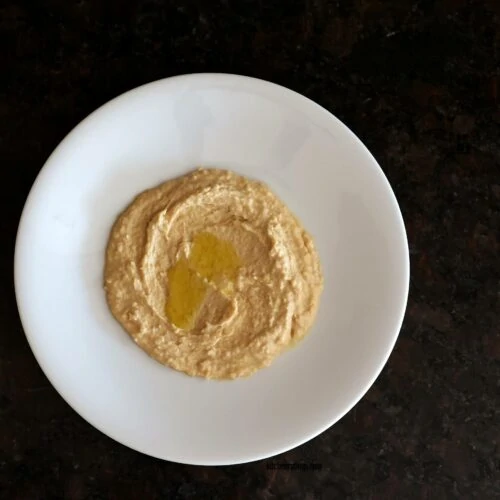
Hummus without Tahini
Equipment
- Large bowl
- Large pot
- Food processor
Ingredients
- 1 pound dried chickpeas
- 4 tbsp water
- 1 tbsp lemon juice
- 3/4 tbsp cumin
- 1/2 tsp salt
- 1 garlic clove minced
Instructions
- Soak the chickpeas, covered by 2 inches of water, for at least 8 hours. Or perform a quick soak by boiling the chickpeas for 5 minutes then turning off the heat and soaking for 1 hour. Drain and rinse the chickpeas.
- Return the chickpeas to a pot, cover with water, and bring to a boil. Reduce the heat to a simmer and cook for 1 hour, until the beans are very soft.
- Drain the chickpeas and place in a food processor with the remaining ingredients. Blend until smooth and adjust the seasoning to taste.

